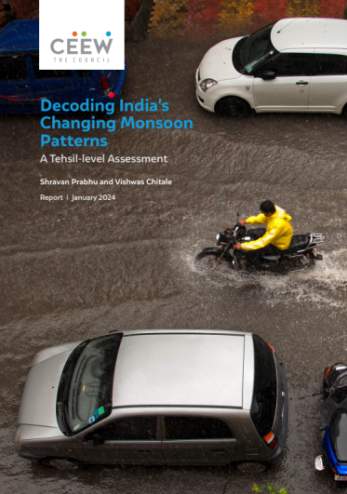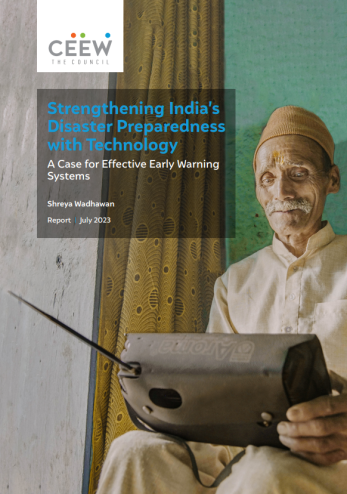Policy Brief
Promoting Neo-traditional Agriculture to Achieve Food and Livelihood Security, and Climate Change Adaptation
Rudresh Sugam, Poulami Choudhury, Jennifer Hartl
July 2016 | Climate Resilience, Sustainable Food Systems, Sustainable Livelihoods
Suggested citation: Sugam, Rudresh K, Poulami Choudhury, and Jennifer Hartl. 2016. Promoting NeoTraditional Agriculture to Achieve Food and Livelihood Security, and Climate Change Adaptation. New Delhi: Council on Energy, Environment and Water.
Overview
This policy brief highlights the traditional agricultural practices that have been followed in different parts of India, including states such as Haryana, Punjab, Bihar, Maharashtra, Madhya Pradesh and Jharkhand. It incorporates various case studies to explain the traditional knowledge and practices being utilised in India for combating climate-related challenges to agriculture. In addition, it highlights the various sources responsible for the loss of traditional agricultural knowledge. It emphasises that there are multiple drivers for the loss of traditional knowledge and genetic diversity, which are often interlinked and mutually reinforcing. Further, it highlights the existing policies that recognise the role of traditional agriculture in food security and climate change adaptation. It also suggests essential policy reforms to promote neo-traditional agriculture to achieve food and livelihood security along with climate change adaptation.
Key highlights
- Farmers in the states of Rajasthan, Gujarat, Karnataka, Maharashtra, Madhya Pradesh, Bihar, and Jharkhand are most vulnerable to climate change impacts.
- Climate change has a negative impact on the major crops of India, i.e., wheat, and rice. Fluctuations in temperature and moisture conditions lead to increased pest attacks.
- Sustainable modern agricultural practices such as the system of crop intensification (SCI) have been readily accepted by farmers in a few places such as Bihar and Punjab.
- Use of sprinklers and drip irrigation systems is also becoming more common, especially in water-scarce areas. However, the incentive structure, existing market conditions, and current policies are not sufficient to promote the rational blending of traditional and neo-traditional practices.
Agricultural vulnerability atlas for India

Drivers for the loss of traditional agriculture knowledge
- Pro-modern agricultural policies: Few initiatives have been undertaken to compensate for the damage done, such as subsidies for vermicomposting, solar pumps, and drip irrigation systems, as well as crop insurance for SRI (system of rice intensification) cultivation.
- Productivity and marketability: Traditionally grown varieties usually do not have very high grain productivity. Thus, the marketability of these products is difficult and non-availability of land forces farmers to choose high-producing varieties.
- Poor documentation: There are no government policies that directly support the documentation of distinctive traditional practices. And due to the poor documentation of agricultural practices many of the innovative practices in agriculture will no longer be known to anyone.
- Non-availability of farmers’ intellectual property rights: There is no system to protect farmers’ rights over traditional varieties, which means that farmers have no incentive to sustain or conserve traditional varieties.
- Lack of location-specific policies: The existing policies do not deal with the location-specific condition and therefore lead to the adoption of the most common advanced practices, resulting in the neglect of locally developed practices and context-specific traditional knowledge.
Key recommendations
- Document traditional practices: Educational institutions and government agencies who have networks in the remotest parts of the country should be engaged and encouraged to start documenting the traditional agricultural practices.
- Adopt participatory decision making: New agricultural policies and plans should be prepared and implemented in consultation with farmers and representatives of agricultural associations.
- Develop the capacity of local communities: Initiatives such as setting up farmer field schools and showing films and dramas on climate-change impacts on agriculture in vernacular languages should be held at more frequent intervals.
- Promote agriculture as a sustainable livelihood option: The education system in India should introduce agriculture as a subject at a school level. This will expose children to various agricultural technologies and incentives.
- Adopt informed policy decisions: Five-year goals or departmental targets should be set realistically and should be aimed at encouraging farmers to grow traditional varieties. This process should involve farmers, department and ministry officials, and research institution representatives.
- Encourage mixed cropping and farming practices: Traditional practices of growing multiple varieties of crops, agroforestry, and agro-fisheries should be encouraged. This should increase the productivity and income of the farmers.
- Integrate water, agriculture, and climate-change risks: It is important to shift to a resource-based planning and development strategy from a crop-based planning and development strategy. It underlines the necessity of various departments and agencies working in pursuit of common goals and targets coming together.
- Shift from maximising yields to minimising risks: Farmers will have to move towards crop varieties and farming practices that are resilient to climate change-related risks. Thus, policymaking should be used indirectly to support the push towards climate-resilient agriculture.
- Phase out chemical farming and shift to organic farming: Decrease the use of chemical fertilisers and replace them with non-damaging natural fertilisers.
Farmers will have to move towards crop varieties and farming practices that are resilient to climate change-related risks. Thus, policymaking should be used indirectly to support the push towards climate-resilient agriculture.










